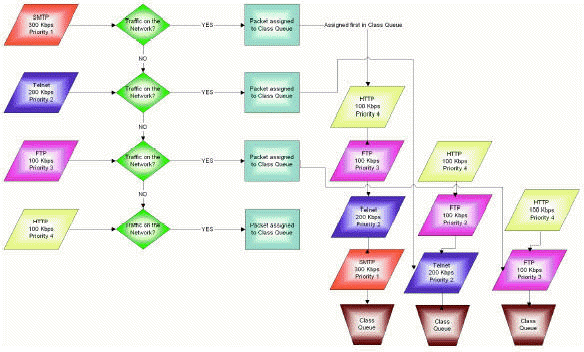 Bandwidth management is a means of allocating
bandwidth resources to critical applications on a network. Without bandwidth
management, an application or a user can take control of all available
bandwidth and prevent other applications or users from using the network.
Because it is impossible to differentiate between types of network traffic, it
is also impossible to control which users or applications have priority on the
network. Applications can also require a specific quantity and quality of
service which cannot be predicted in terms of available bandwidth. This can
make some applications run poorly if bandwidth is not properly allocated to
them when necessary.
Bandwidth management is a means of allocating
bandwidth resources to critical applications on a network. Without bandwidth
management, an application or a user can take control of all available
bandwidth and prevent other applications or users from using the network.
Because it is impossible to differentiate between types of network traffic, it
is also impossible to control which users or applications have priority on the
network. Applications can also require a specific quantity and quality of
service which cannot be predicted in terms of available bandwidth. This can
make some applications run poorly if bandwidth is not properly allocated to
them when necessary.
Bandwidth management works by
sorting outbound network traffic into classes by application and service type.
Traffic is then scheduled according to minimum and maximum bandwidth
configured for each traffic type.
Why Use Bandwidth Management?
Corporate networks using
intranets for information sharing and Web navigation have an increased demand
for bandwidth, but simply adding on more connections or larger connections (T1
lines or larger) doesn�t address the bandwidth issue because availability is
not guaranteed. Nearly all network links are shared by more than one user or
application which means available bandwidth is shared between all users and
all applications. Using bandwidth management to allocate bandwidth to
applications or users during peak times can prevent traffic congestion on then
network. Temporary network congestion can be improved by using bandwidth
management; however, if a network is continuously congested, improvements to
the link that provide greater capacity are suggested.
SonicWALL Bandwidth Management
Bandwidth Management is
controlled by the SonicWALL Internet Security Appliance on outbound traffic
only. It allows network administrators to guarantee minimum bandwidth and
prioritize traffic based on Rules created in the Access section of the
SonicWALL Management interface. By controlling the amount of bandwidth to an
application or user, the network administrator can prevent a small number of
applications or users to consume all available bandwidth.

Bandwidth management works
by allocating traffic to a class based upon application type, source or
destination addresses, or a combination of both. It then assigns individual
limits for each class of network traffic. By assigning priorities to network
traffic, applications requiring a quick response time, such as telnet, can
take precedence over traffic requiring less response time, such as FTP.
Balancing the bandwidth allocated to different network traffic and then
assigning priorities to traffic can improve network performance.
Bandwidth Management Features &
Benefits
Traffic Type
Outgoing traffic is managed
according to traffic type: Telnet, FTP, HTTP, etc.
IP Address
Network Access Rules can be
configured to allocate bandwidth based on IP addresses.
VPN Allocation
VPN traffic can also be managed by
enabling bandwidth management in the VPN configuration, and then specifying
the Guaranteed, Maximum, and priority of all VPN traffic through the
SonicWALL. Bandwidth management cannot be configured for individual VPN
Security Associations. It can only be configured for all VPN traffic.
Full Control
The network administrator has full
control of network traffic and can prevent traffic congestion on the
network.
Application Management
Prevent a small number of
applications and users from consuming all available bandwidth.
QoS Policy Driven
Quality of Service policies can be
implemented across the network allowing priority applications to run
smoothly.